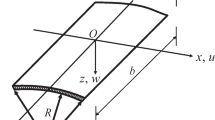Abstract
Different specimen types (double cantilever beam: DCB, compact tension: CT, single edge notched in tension: SENT) have been numerically studied (with special finite elements) for ten wood species and for cracks situated in a material plane of symmetry (the crack is denoted xy with x the direction of the normal to the crack plane and y the direction of propagation). Single-edge notched speciments used in RL, TL directions appear to be insensitive to the orthotropic properties of the material. So, calibration known for isotropic materials can be used in stress intensity factor calculations. In transverse directions (LT, LR), such specimens could be used with a double height. Small differences, but depending on the species tested, have also been obtained in TR and RT directions. Calibration of CT specimens of an isotropic material cannot be used even in TL and RL directions. A calibration acceptable for all the studied species is proposed. A different calibration is also given in the TR direction. It is suggested, however, not to use specimens in the RT direction without a calibration specific for the wood species tested. DCB specimens could be used in RL, TL and TR directions with a calibration which is a function of elastic moduli. This calibration is obtained from analytical calculations. In other directions, these specimens do not offer any experimental interest.
Resume
L’orthotropie du matériau bois correspond à six directions principales de propagation de fissure RL, TL: RT, TR et LR. LT (le premier indice correspond à la normale au plan de fissure, le deuxième à la direction de propagation). Pour déterminer les facteurs d’intensité de contraintes en pratique, les éprouvettes utilisées sont associées à une calibration obtenue par calcul numérique sur des milieux isotropes. D’une façon générale, ces calibrations ne sont pas valables pour les milieux fortement orientés tels que le bois.
Dans cet article, différents types d’éprouvettes de traction (double poutre en flexion: DCB, traction compacte: CT, simple entaille latérale en traction: SENT) ont été étudiées numériquement (éléments finis singuliers), pour une dizaine d’essences de bois (masses volumiques comprises entre 0,1 et 1,28 g cm−3) et pour une fissure située suivant un axe matériel. L’éprouvette SENT, dans les directions RL, TL apparaît indépendante de l’orthotropie du matériau. Dans les directions transversales (LR, LT) elle pourrait être utilisée en doublant sa hauteur. Des différences faibles dépendant de l’essence existent aussi entre les directions TR et RT.
La calibration de l’éprouvette CT en milieu isotrope ne peut pas être utilisée même pour les directions de fendage RL et TL. Pour ces deux dernières, une relation corrective valable pour toutes les essences utilisées avec une bonne approximation est proposée. Dans la direction TR, une calibration différente est également proposée. Par contre, dans la direction RT, il est suggéré de ne pas utiliser le spécimen sans calibration spécifique au matériau essayé.
L’éprouvette DCB, quant à elle, pourrait être employée dans les directions RL, TL ou TR à l’aide d’une calibration issue de calculs analytiques, fonction explicite des constantes élastiques. Cette éprouvette ne présente pas d’intérêt pratique dans les autres directions de propagation.
Similar content being viewed by others
References
Sih, G. C., Paris, P. C. and Irwin, G. R., ‘On crack in rectilinear anisotropic bodies’,Int. J. Fract. 1 (1965) 189–203.
Barrett, J. D., ‘Effect of crack front width on fracture toughness of Douglas Fir’,Eng. Fract. Mech. 8 (1976) 711–717.
Walsh, P. F., ‘Linear fracture mechanics in orthotropic materials’,ibid. 4 (1972) 533–541.
Mandell, J. F., McGarry, F. J., Wang, S. S. and Im, J., ‘Stress intensity factors for anisotropic fracture test specimens of several geometries’,J. Compos. Mater. 8 (1974) 106–116.
Valentin, G. and Caumes, P., ‘Crack propagation in mixed mode in wood: a new speciment’,Wood Sci. Tech. 23 (1989) 43–53.
Hunt, D. G. and Croager, W. P., Mode II fracture toughness of wood measured by a mixed-mode test method.J. Mater. Sci. Lett. 1 (1982) 77–79.
Valentin, G. and Lahna, F., ‘Facteur d’intensité de contrainte de l’éprouvette DCB dans le cas d’un matériau orthotrope’,C. R. Acad. Sci. Paris, Serie II299(3) (1984) 85–88.
Cariou, J-L., ‘Caractérisation d’un matériau viscoélastique anisotrope: le bois’, thèse Université de Bordeaux, No. 107 (1987).
Lahna, F., ‘Mécanique de la rupture des matériaux orthotropes—application au bois’, thèse Université Bordeaux, No. 1876 (1983).
Guitard, D., ‘Mécanique du matériau bois et composites’, (Cepadues, Toulouse, 1987).
Kanninen, M. F., ‘An augmented double cantilever beam model for studying crack propagation and arrest’,Int. J. Fract. 9(1) (1973) 83–92.
Komatsu, K., Sasaki, H. and Maku, T., ‘Strain energy release rate of double cantilever specimen with finite thickness of adhesive layer’,Wood Res. (1976) 59–60.
Wright, K. and Fonselius, M., ‘Fracture mechanics testing of wood methods for mode I and mode II’, in ‘From Materials Science to Construction Materials Engineering’, Proceedings of 1st International RILEM Congress, Paris, September 1987 (Chapman and Hall, 1987) pp. 764–771.
Barrett, J. D. and Foschi, R. O., ‘Mode II stress intensity factors for cracked wood beams’,Eng. Fract. Mech. 9 (1977) 371–378.
ASTM E399-83, ‘Standard test method for plane strain fracture toughness of metallic materials’ (1983).
Henshell, R. D. and Shaw, K. G., ‘Crack tip finite elements are unnecessary’,Int. J. Num. Meth. Eng. 9 (1975) 495–507.
Barsoum, R. S., ‘Triangle quarter point elements as elastic and perfectly plastic elements’,ibid. 11 (1978) 85–98.
Sih, C. F., de Lorenzi, H. G. and German, M. D., ‘Crack extension modelling with singular quadratic isoparametric element”,Int. J. Fract. 12 (1976) 647–651.
Johnson, J. A., ‘Crack initiation in wood plates’,Wood Sci. 6(2) (1973) 151–158.
Srawley, J. E. and Gross, B., ‘Stress intensity factors by boundary collocation for single edge notched specimens subject to splitting forces’ (NASA, Washington, DC, 1966).
Author information
Authors and Affiliations
Rights and permissions
About this article
Cite this article
Valentin, G., Adjanohoun, G. Applicability of classical isotropic fracture mechanics specimens to wood crack propagation studies. Materials and Structures 25, 3–13 (1992). https://doi.org/10.1007/BF02472207
Issue Date:
DOI: https://doi.org/10.1007/BF02472207




